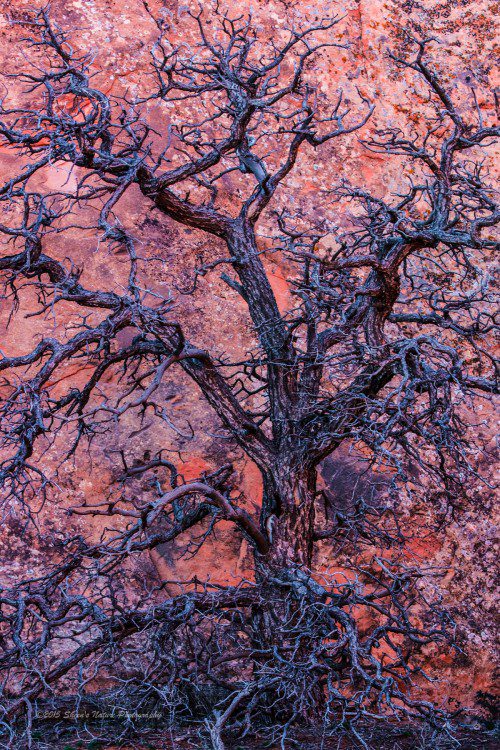Thanks to social media, travel publications and TV, we have many ways to view photographic iconic scenes. From the Arches in Utah, to landscapes in Provence and the many natural and man-made wonders of the world – inspiration is at our fingertips. This inspiration encourages us to travel, to find like subjects, and get creative with our own techniques. Seeing icons over and over again can intentionally and unintentionally impact our eye when we have the opportunity to photograph it first hand.
We'll explore the pros and cons (and how to avoid them!) of photographing such icons. The photos we'll use as examples are from a recent trip to Moab, Utah. Moab is known for natural rock arches, mountain ranges, raw terrain and big blue skies.
The 4 Pros:
- Travel to known destinations – When you commit to traveling to photography iconic scenes and subjects, you are tapping in to your ‘inner-adventurer.' Plus, there are many tips, suggestions and references across the web on maximizing the moment.
- Easy to find – It's not difficult to locate iconic locations. Accessibility varies based on location, climate, time of year. Online and published travel guides, provide necessary details that will help make it easier to find.
- People relate quickly to the image – Many iconic places are photographed and displayed in galleries, books and online. As a result, they get a double-take as they bring back memories if the location is recognized.
- Easy to find guides, photographers & workshops – Many iconic locations have their own local ‘photographer experts' whose business is serving as local guides. Additionally, there are professional photographers who lead workshops across many iconic photography destinations. I recently attended the Moab workshop led by Richard Bernabe along with other photographers. Richard's knowledge of the area combined with technical and creative tips helped to maximize the limited photography time I had.
The 4 Potential Cons:
- It's easy to photograph the repeat view – Plan to take the ‘iconic' view. At the same time, also consider before you arrive other techniques and potential views that you may want to use.
- Everyone has one – As in the photo above taken at Mesa Arch in Moab, Utah, there are many photographs taken from that very spot. It's easy to discard ‘your version' if you compare it to others. Don't. This was your trip, your moment, with your post processing. I personally like the photo in how it looks along with the fact that I'll never forget being shoulder to shoulder with a band of photographers each wanting to capture their own version.
- Sometimes you miss other great moments/subjects chasing the icon – Moab's iconic arches at sunrises and sunsets are beautiful photography subjects. There are also other fantastic photography opportunities to tackle. Starlights, star trails and the milky way at night, unique trees and rock formations at other times of the day. The Milky Way was an amazing sight. To capture this, my settings were f/2.8, ISO 1600, shutter speed was set 30 seconds. The shooting star was an unplanned moment (I was a bit giddy when it happened!).
- The hot spots are crowded – some locations are filled with photographers and tourists. Navigating to find your spot and protecting your equipment from getting bumped should be top of mind at all times. During the workshop we saw some photographers getting a bit irritated (and embarrassingly rude) with other tourists for ‘getting in their shot.' The reality is that these iconic locations are for everyone and politeness goes a long way.
4 Recommendations:
- Take advantage of the opportunity to photograph icons – take the ‘standard' shot and take others using different vantage points & perspectives.
- Don't limit your photographs to the icons only. Create your own photographic experience by exploring other nearby paths and areas.
- If you can't travel to the famous icons that shouldn't stop you from photographing local icons. Jason Row's article of How to be a Tourist in Your Own City offers tips on finding new inspiration locally.
- Learn before you go. In order to maximize your valuable time, do your research in advance. Ensure you have a plan that enables you to make the most of your experience. For those sunrise shots – that means an early call. Have directions ready to go before hand so you can arrive in time to prepare your shot safely.
Near or far, an iconic shot awaits. Let's get going!









4 Comments
I still like going to the National parks. Yes, Mesa Arch reminded me of my high school basketball days where you had to box out to protect your space. One of my favorite images is of Bryce Canyon at sunrise where just a fee hoodoos are lighted. You have to ame it your own.
LOL – “Box Out”….my husband used to be a varsity basketball coach – great analogy!
This past fall I went to Aspen, CO to take fall pictures at Maroon Lake, one morning it was literally tripod to tripod so I started taking pictures of the crowd 🙂 Also most people go for the easy shot, ignoring the second lake about a 30-minute hike from the main area. The key is to look for different angles/views and make something unique…
Aspen is a beautiful place…you are absolutely correct – they key is to find the unique and make the place your own.